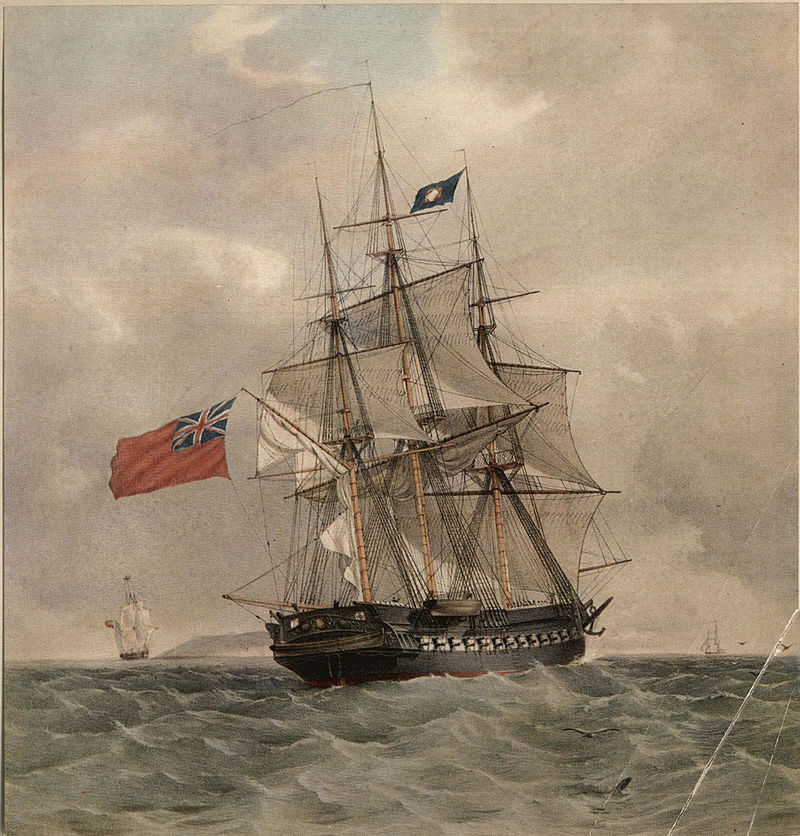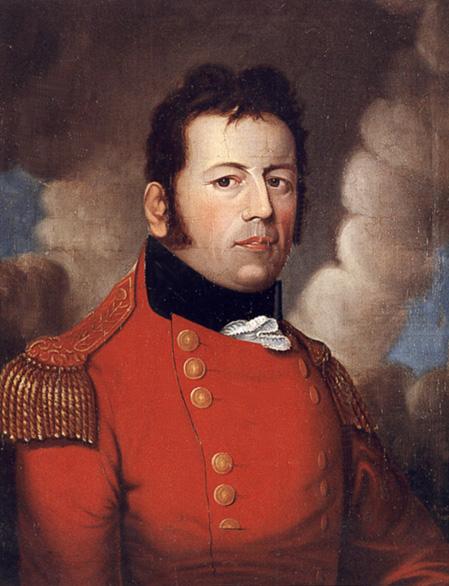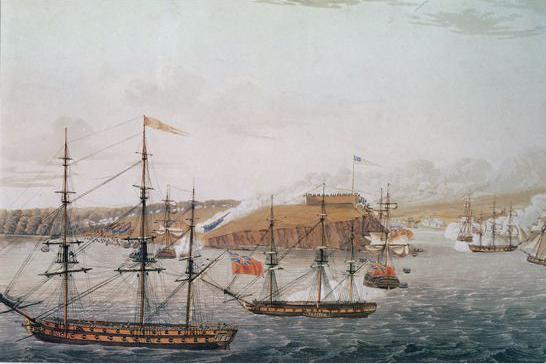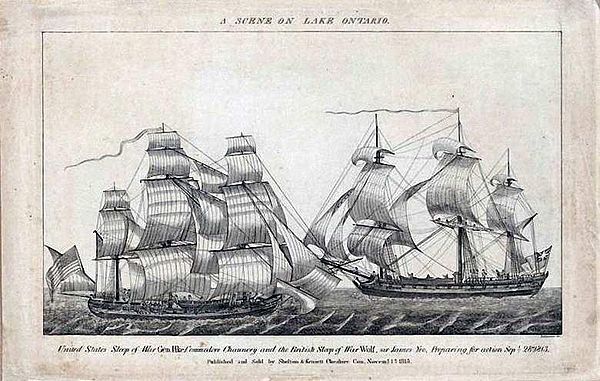Naval Hero Sir James Lucas Yeo – Part 3
 Parts 1 and 2 of this blog introduced us to the real-life naval hero Sir James Lucas Yeo (1782 – 1818), a handsome and dashing officer who might seem overdone were he to step from the pages of a Jane Austen novel. ( Click here to read Part 1, or Part 2 if you missed them) The second articles ended with Yeo, still under thirty, knighted in 1810 for his capture of the French colony of Cayenne by a British-Portuguese task force under his command. His “lead from the front” approach, whether at sea or in attacks on land fortifications, made him an ideal frigate captain, command of the 32-gun HMS Southampton being his reward for taking Cayenne. In her, in 1811, he captured the French privateer, the Amethyste, a prize which is likely to have benefitted him and his crew financially.
Parts 1 and 2 of this blog introduced us to the real-life naval hero Sir James Lucas Yeo (1782 – 1818), a handsome and dashing officer who might seem overdone were he to step from the pages of a Jane Austen novel. ( Click here to read Part 1, or Part 2 if you missed them) The second articles ended with Yeo, still under thirty, knighted in 1810 for his capture of the French colony of Cayenne by a British-Portuguese task force under his command. His “lead from the front” approach, whether at sea or in attacks on land fortifications, made him an ideal frigate captain, command of the 32-gun HMS Southampton being his reward for taking Cayenne. In her, in 1811, he captured the French privateer, the Amethyste, a prize which is likely to have benefitted him and his crew financially.

HMS Pomone (1805) typical frigate of this era
When war broke out with the United States in 1812, Yeo was stationed in the Bahamas and in the course of the year captured another French privateer, the Heureuse Réunion. This was followed by his taking an American brig-of-war, the USS Vixen, in November 1812. Yeo was not to profit from the Vixen however – both she and HMS Southampton were wrecked five days later on Conception Island in the Bahamas. Yeo was duly court-martialled for the loss of these ships but had his sword returned to him on the grounds that an uncharted reef was the cause of the accident. (It is hard to imagine today just how limited charts were in this period – it was only later in the nineteenth century that a massive international hydrographic effort, largely driven by the Royal Navy, led to most of the world’s coastlines being surveyed and charted for the first time.)
The War of 1812 between Britain and the United States was by now in full swing and the Canadian border represented a major – and possibly decisive – front. Critical to this was naval control of the Great Lakes, most especially Lake Ontario, the southern and south-eastern shores of which could provide the British with access to New York State and threaten the Hudson Valley. A “Lakes Service” command was accordingly established by the Royal Navy, with headquarters at Kingston, at the eastern end of Lake Ontario’s Canadian shore – and almost directly across from the United States base and shipyard at Sacket’s Harbor on the opposite shore. Situated close to the point of exit of the St. Lawrence river, whichever nation that managed to occupy both these locations would be well situated to dominate the lake.

Sir George Prévost
Command of the Lakes Service was entrusted to Yeo and he arrived, as a Commodore, in 1813. The skill he had demonstrated in previous amphibious operations was probably a strong influence on the Navy choosing him as capture of Sacket’s Harbor would demand an opposed landing. The American shipyards were a major objective – they were to build no less than eleven warships in the course of the conflict – and a British attempt at capture had been repulsed before Yeo’s arrival. In early 1813 the balance of naval forces on the lake were in favour of the Americans and Yeo concentrated on getting a sloop, HMS Wolfe, completed and some smaller vessels refitted as warships. The major threat was however the intelligence that the Americans were building a similarly-sized sloop, the General Pike, at Sacket’s Harbor. Pre-emption of this was possibly a major factor in the British decision to mount an amphibious assault. Had Yeo been in sole command – and indeed had he stronger forces – this might have been successful. In this era of intense inter-service rivalries (a situation that sometimes seems to occur even today!) it was however inconceivable that overall command would not be taken by the senior army officer present, Lieutenant General Sir George Prévost,, who also happened to be Governor General of Canada.
 Contemporary view of British ships off Sacket’s Harbor
Contemporary view of British ships off Sacket’s Harbor
The second battle of Sacket’s Harbor, on May 28th and 29th 1813, resulted in another repulse, despite the British force arriving there when much of the American naval force was at the other end of the lake. Yeo’s larger, deep- draught, vessels could not come close inshore to provide covering fire and the shallower gunboats that could were armed only with carronades, weapons only effective at very short range. Only the 16-gun brig HMS Beresford, could be taken close enough inshore – by use of sweeps – to deliver the necessary bombardment capability. This was enough to disable one of the American gun emplacements and rounds from Beresford also fell in the dockyard where the General Pike was under construction. Believing a British victory imminent, American orders were given to burn the General Pike and large quantities of stores. Despite this limited success the landing itself did not go well – Yeo, characteristically, had gone ashore with the assault force – and it was beaten back. The blame of the failure was largely attributed to Prévost, the army commander, who failed to push what advantages he had. The destruction of the General Pike was incomplete however. She was brought into service and on 28th September she fought a successful action with HMS Wolfe, dismasting her but nevertheless letting her escape with other British ships.
 A contemporary print – USS General Pike facing up to HMS Wolf, 28th September 1813
A contemporary print – USS General Pike facing up to HMS Wolf, 28th September 1813
The following year, 1814, was dominated by a building race between the British and Americans. Yeo pulled ahead in this contest and with two frigates now at his disposal, each more powerful than the brigs and sloops that constituted the American force, he was able to blockade Sacket’s Harbor. He was simultaneously building a 112-gun First Rate ship-of-the line, the HMS St. Lawrence. When this was completed at the year’s end Yeo now had effective command of the lake, and he had two more similar ships also under construction. The Americans were not idle and also had two equally large warships on the stocks. Neither was completed. Had this unnecessary war not ended in 1815, a major naval battle might have been fought between ships-of-the-line on Lake Ontario.
 The never-completed American line-of-battle ship USS New Orleans. Laid down at Sacket’s Harbor in 1814, she was not broken up until 1883.
The never-completed American line-of-battle ship USS New Orleans. Laid down at Sacket’s Harbor in 1814, she was not broken up until 1883.
Yeo’s subsequent career was short and tragic. He was awarded important commands on both the West African and West Indian stations – both notoriously unhealthy, and he was to die in 1818. Had he lived he would almost certainly have reached the highest ranks in the Royal Navy. This daring, handsome, capable man had however packed more into his 35 years than many other officers achieved in an entire lifetime.
Naval fiction enters the Age of Fighting Steam
Since its original publication, the Dawlish Chronicles novel Britannia’s Spartan has consistently scored 5-star reviews
For more details, click on the image below
The Dawlish Chronicles – now up to eight volumes, and counting …
A sixth free short-story, Britannia’s Rescuers, set in 1875, is now available for download (with five others) to your Kindle. Access it by registering for the Dawlish Chronicles mailing list – just click on the banner below. You’ll be kept updated on new books and it facilitates e-mail contact between Antoine Vanner and his readers.



